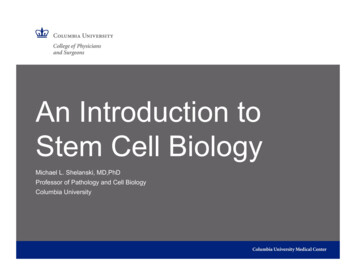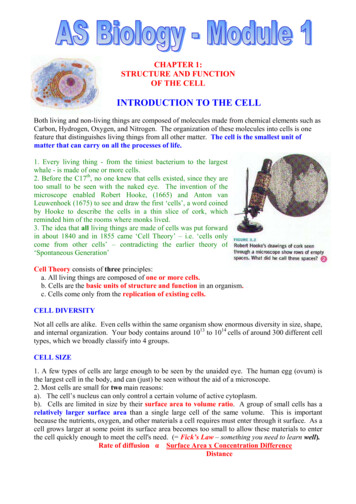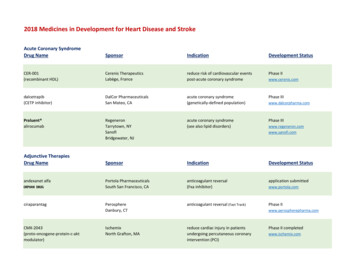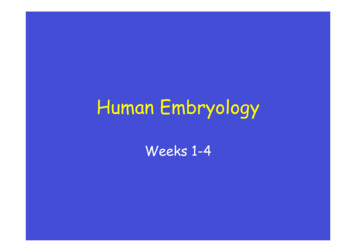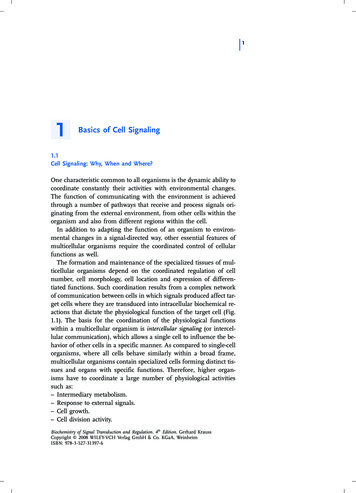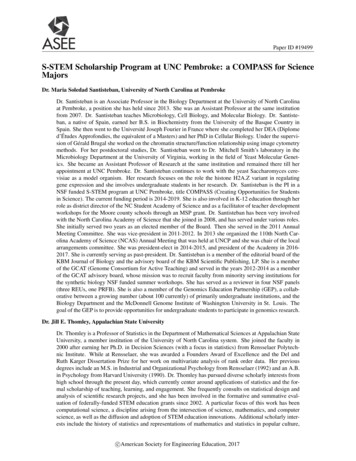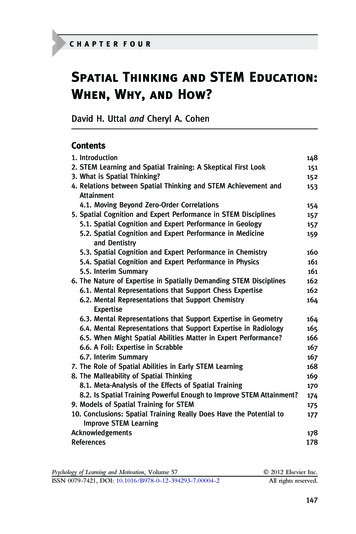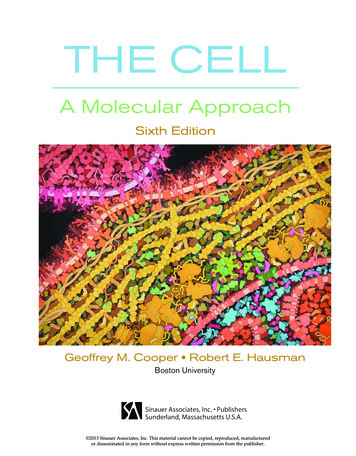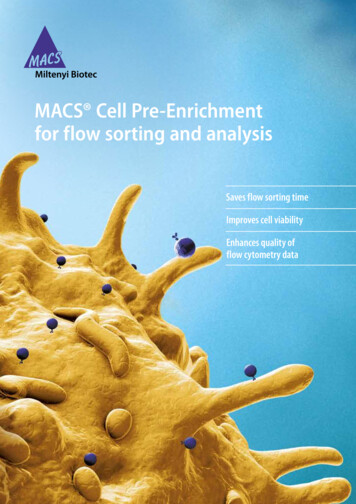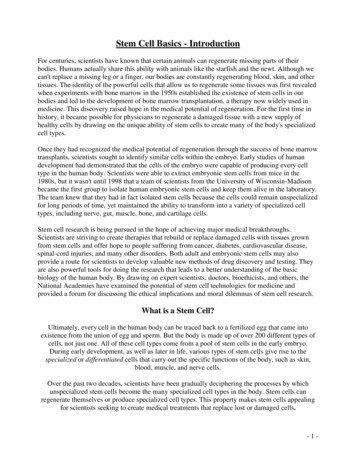
Transcription
Stem Cell Basics - IntroductionFor centuries, scientists have known that certain animals can regenerate missing parts of theirbodies. Humans actually share this ability with animals like the starfish and the newt. Although wecan't replace a missing leg or a finger, our bodies are constantly regenerating blood, skin, and othertissues. The identity of the powerful cells that allow us to regenerate some tissues was first revealedwhen experiments with bone marrow in the 1950s established the existence of stem cells in ourbodies and led to the development of bone marrow transplantation, a therapy now widely used inmedicine. This discovery raised hope in the medical potential of regeneration. For the first time inhistory, it became possible for physicians to regenerate a damaged tissue with a new supply ofhealthy cells by drawing on the unique ability of stem cells to create many of the body's specializedcell types.Once they had recognized the medical potential of regeneration through the success of bone marrowtransplants, scientists sought to identify similar cells within the embryo. Early studies of humandevelopment had demonstrated that the cells of the embryo were capable of producing every celltype in the human body. Scientists were able to extract embryonic stem cells from mice in the1980s, but it wasn't until 1998 that a team of scientists from the University of Wisconsin-Madisonbecame the first group to isolate human embryonic stem cells and keep them alive in the laboratory.The team knew that they had in fact isolated stem cells because the cells could remain unspecializedfor long periods of time, yet maintained the ability to transform into a variety of specialized celltypes, including nerve, gut, muscle, bone, and cartilage cells.Stem cell research is being pursued in the hope of achieving major medical breakthroughs.Scientists are striving to create therapies that rebuild or replace damaged cells with tissues grownfrom stem cells and offer hope to people suffering from cancer, diabetes, cardiovascular disease,spinal-cord injuries, and many other disorders. Both adult and embryonic stem cells may alsoprovide a route for scientists to develop valuable new methods of drug discovery and testing. Theyare also powerful tools for doing the research that leads to a better understanding of the basicbiology of the human body. By drawing on expert scientists, doctors, bioethicists, and others, theNational Academies have examined the potential of stem cell technologies for medicine andprovided a forum for discussing the ethical implications and moral dilemmas of stem cell research.What is a Stem Cell?Ultimately, every cell in the human body can be traced back to a fertilized egg that came intoexistence from the union of egg and sperm. But the body is made up of over 200 different types ofcells, not just one. All of these cell types come from a pool of stem cells in the early embryo.During early development, as well as later in life, various types of stem cells give rise to thespecialized or differentiated cells that carry out the specific functions of the body, such as skin,blood, muscle, and nerve cells.Over the past two decades, scientists have been gradually deciphering the processes by whichunspecialized stem cells become the many specialized cell types in the body. Stem cells canregenerate themselves or produce specialized cell types. This property makes stem cells appealingfor scientists seeking to create medical treatments that replace lost or damaged cells.-1-
-2-
Types of Stem CellsStem cells are found in all of us, from the early stages of human development to the end of life. Allstem cells may prove useful for medical research, but each of the different types has both promiseand limitations. Embryonic stem cells, which can be derived from a very early stage in humandevelopment, have the potential to produce all of the body's cell types. Adult stem cells, which arefound in certain tissues in fully developed humans, from babies to adults, may be limited toproducing only certain types of specialized cells. Recently, scientists have also identified stem cellsin umbilical cord blood and the placenta that can give rise to the various types of blood cells.Embryonic Stem CellsA blastocyst (BLAST-oh-sist), is a pre-implantation embryo that develops 5 days after thefertilization of an egg by a sperm. It contains all the material necessary for the development of acomplete human being. The blastocyst is a mostly hollow sphere of cells that is smaller than theperiod at the end of this sentence. In its interior is the inner cell mass, which is composed of 30-34cells that are referred to by scientists as pluripotent because they can differentiate into all of the celltypes of the body.In comon usage, "embryo" can refer to all stages of development from fertilization until a somewhatill-defined stage when it is called a fetus. Scientists use terms such as "morula" and "blastocyst" torefer to precise, specific stages of pre-implantation development. In order to be as precise aspossible, this booklet uses the scientific terms when describing scientific concepts but uses the term"embryo" where more precision seemed likely to confuse rather than clarify.In normal development, the blastocyst would implant in the wall of the uterus to become theembryo and continue developing into a mature organism. Its outer cells would begin to form theplacenta and the inner cell mass would begin to differentiate into the progressively more specializedcell types of the body.When the blastocyst is used for stem cell research, scientists remove the inner cell mass and placethese cells in a culture dish with a nutrient-rich liquid where they give rise to embryonic stem cells.Embryonic stem cells seem to be more flexible than stem cells found in adults, because they havethe potential to produce every cell type in the human body. They are also generally easier to collect,purify and maintain in the laboratory than adult stem cells.Scientists can induce embryonic stem cells to replicate themselves in an undifferentiated state forvery long periods of time before stimulating them to create specialized cells. This means that just afew embryonic stem cells can build a large bank of stem cells to be used in experiments. However,such undifferentiated stem cells could not be used directly for tissue transplants because they cancause a type of tumor called a teratoma. To be used for therapies, embryonic stem cells would firstneed to be differentiated into specialized cell types.Some find embryonic stem cell research to be morally objectionable, because when scientistsremove the inner cell mass, the blastocyst no longer has the potential to become a fully developedhuman being.-3-
-4-
Sources of Embryonic Stem CellsIn Vitro FertilizationThe largest potential source of blastocysts for stem cell research is from in vitro fertilization (IVF)clinics. The process of IVF requires the retrieval of a woman's eggs via a surgical procedure afterundergoing an intensive regimen of "fertility drugs," which stimulate her ovaries to producemultiple mature eggs.When IVF is used for reproductive purposes, doctors typically fertilize all of the donated eggs inorder to maximize their chance of producing a viable blastocyst that can be implanted in the womb.Because not all the fertilized eggs are implanted, this has resulted in a large bank of "excess"blastocysts that are currently stored in freezers around the country. The blastocysts stored in IVFclinics could prove to be a major source of embryonic stem cells for use in medical research.However, because most of these blastocysts were created before the advent of stem cell research,most donors were not asked for their permission to use these left-over blastocysts for research.The IVF technique could potentially also be used to produce blastocysts specifically for researchpurposes. This would facilitate the isolation of stem cells with specific genetic traits necessary forthe study of particular diseases. For example, it may be possible to study the origins of an inheriteddisease like cystic fibrosis using stem cells made from egg and sperm donors who have this disease.The creation of stem cells specifically for research using IVF is, however, ethically problematic forsome people because it involves intentionally creating a blastocyst that will never develop into ahuman being.Nuclear Transfer:The process called nuclear transfer offers another potential way to produce embryonic stem cells.In animals, nuclear transfer has been accomplished by inserting the nucleus of an alreadydifferentiated adult cell-for example, a skin cell-into a donated egg that has had its nucleusremoved. This egg, which now contains the genetic material of the skin cell, is then stimulated toform a blastocyst from which embryonic stem cells can be derived. The stem cells that are createdin this way are therefore copies or "clones" of the original adult cell because their nuclear DNAmatches that of the adult cell.As of the summer of 2006, nuclear transfer has not been successful in the production of humanembryonic stem cells, but progress in animal research suggests that scientists may be able to use thistechnique to develop human stem cells in the future.Scientists believe that if they are able to use nuclear transfer to derive human stem cells, it couldallow them to study the development and progression of specific diseases by creating stem cellscontaining the genes responsible for certain disorders. In the future, scientists may also be able tocreate "personalized" stem cells that contain only the DNA of a specific patient. The embryonicstem cells created by nuclear transfer would be genetically matched to a person needing atransplant, making it far less likely that the patient's body would reject the new cells than it wouldbe with traditional tissue transplant procedures.Although using nuclear transfer to produce stem cells is not the same as reproductive cloning, someare concerned about the potential misapplication of the technique for reproductive cloning purposes.-5-
Other ethical considerations include egg donation, which requires informed consent, and thepossible destruction of blastocysts.Producing Embryonic Stem Cells Using Nuclear Transfer Is Not the Same as ReproductiveCloningThe use of nuclear transfer to develop disease-specific stem cells can be called research cloning,and the use of this technique for personalized tissue transplants is sometimes called therapeuticcloning. These terms must be carefully distinguished from reproductive cloning, in which the intentis to implant a cloned embryo in a female's womb and allow it to develop fully into an individual.This was the technique by which Dolly the sheep was made and is now widely used forreproductive cloning in animals. In humans, however, reproductive cloning has been activelydiscouraged by most in the scientific community. The National Academies concluded," Humanreproductive cloning should not now be practiced. It is dangerous and likely to fail" in the 2002report Scientific and Medical Aspects of Human Reproductive Cloning.-6-
Adult Stem CellsAdult stem cells are hidden deep withinorgans, surrounded by millions ofordinary cells, and may help replenishsome of the body's cells when needed. Infact, some adult stem cells are currentlybeing used in therapies. They have beenfound in several organs that need aconstant supply of cells, such as theblood, skin, and lining of the gut, andhave also been found in surprisingplaces like the brain, which is not knownto readily replenish its cells.Unlike embryonic stem cells, adult stemcells are already somewhat specialized.For example, blood stem cells normallyonly give rise to the many types of bloodcells, and nerve stem cells can onlymake the various types of brain cells.Recent research however, suggests thatsome adult stem cells might be moreflexible than previously thought, andmay be made to produce a wider varietyof cell types. For example, someexperiments have suggested that bloodstem cells isolated from adult mice mayalso be able to produce liver, muscle,and skin cells, but these results are notyet proven and have not beendemonstrated with human cells.Nevertheless, scientists are working onfinding a way to stimulate adult stemcells, or even other types of adult cells,to be more versatile. If they succeed, itcould provide another source ofunspecialized stem cells.-7-
-8-
Identifying Stem CellsAs early as 1961, scientists knew that adult bone marrow contained cells that could make all of theblood cell types. But it wasn't until 1988 that those stem cells were isolated as pure populations.Why did it take so long? The techniques for identifying stem cells have only recently beendeveloped. Partly, this is because adult stem cells are, by their very nature, inconspicuous in shape,size, and function. They also tend to hide deep in tissues and are present only in very low numbers,making their identification and isolation like finding a needle in a haystack.How do scientists know when they have found a stem cell? Every cell displays an array of proteinson its surface; different cell types have different proteins. Scientists can use these surface proteinsas "markers" that characterize individual cell types-a type of "molecular ID." For example, usingmolecules that recognize and attach to specific surface proteins and that can fluoresce under certainwavelengths of light, scientists can visually tell the difference between a blood stem cell and amature white blood cell. Unfortunately, not all stem cells can now be identified in this mannerbecause scientists have not yet identified markers for all stem cell types. Scientists also identifystem cells by observing their behavior in the laboratory: stem cells must be able to remainunspecialized and self-renew for long periods of time. Scientists believe that there might be moretypes of adult stem cells than the handful that have already been identified, but finding them is adifficult process.Culturing Cell Lines and Stimulating Stem Cells to DifferentiateCell culture is a term that refers to the growth and maintenance of cells in a controlled environmentoutside of an organism. A successful stem cell culture is one that keeps the cells healthy, dividing,and unspecialized.The culturing of stem cells is the first step in establishing a stem cell line—a propagating collectionof genetically identical cells. Cell lines are important because they provide a long-term supply ofmultiplying cells that can be shared among scientists for research and therapy development. TheNational Academies report Stem Cells and the Future of Regenerative Medicine (2001) describedsome of the challenges of maintaining cell lines: "Over time, all cell lines change, typicallyaccumulating harmful genetic mutations. There is no reason to expect stem cell lines to behavedifferently. While there is much that can be learned using existing stem cell lines, such concernsnecessitate continued monitoring of these cells as well as the development of new stem cell lines inthe future."Once they have established a stable stem cell line, scientists start the process of causing the stemcells to differentiate into specialized cell types. The cellular environment in which stem cellsnaturally reside provides scientists with clues about how to make them differentiate in a culturedish. For example, in the bone marrow, where blood stem cells reside, bone cells send physical andchemical signals that tell the blood stem cells when to differentiate. Scientists are just beginning tounderstand these signals and have developed ways to mimic the natural processes in cell cultures.Usually, the technology involves adding certain proteins to the cell culture and, in some cases,introducing specific genes into the stem cells.-9-
It will be essential that scientists are sure that stem cells have fully differentiated before they canuse them for medical applications. If completely undifferentiated stem cells (such as embryonicstem cells) are implanted directly into an organism, they can cause a type of tumor called ateratoma, which scientists have observed in experiments using mice. Semi-specialized adult stemcells and differentiated cells derived from embryonic stem cells are unlikely to cause teratomas.The Role of Animals in Stem Cell ResearchFor medical research, as well as for research that explores the basic processes in the development oforganisms and diseases, scientists often rely on animals. Implanting human cells into animals suchas mice has long been common practice in order to test the safety and effectiveness of new drugs,procedures, and medical devices before clinical testing in human volunteers.For stem cell research, scientists use animals to make sure the stem cells are able to incorporate intothe tissue, do not cause any harmful consequences, and function in concert with the rest of the body.For example, before using stem cells to replace the pancreatic cells that are destroyed by type Idiabetes in humans, scientists will transplant human stem cells into a mouse to see whether the stemcells yield healthy, insulin-producing cells. If their methods prove successful in mice, scientists mayeventually apply the technology to developing treatments for diabetes in humans.Animal studies can also reveal how human cells differentiate during normal development. Forexample, scientists may implant human stem cells into a developing mouse to observe the processesinvolved in building and organizing the different tissue types that make up the human body.Scientists can also trace the development and progression of certain diseases within an animal. Byimplanting human stem cells that lead to a particular disease into a mouse blastocyst, scientists canobserve when and how the afflicted cells begin to show signs of disease and can test drugs thatmight prevent that process.Organisms that contain cells or tissues from another individual of the same or a different species arecalled chimeras. A common example of a chimera is a mouse that has been injected with somehuman cells so that it can be used for studying a human disease or testing a new drug. A person whohas had a blood transfusion or a person who has received a heart valve transplant from a pig istechnically a chimera, as well. The making of chimeras for research has unique ethical implicationsthat have been the topic of discussions among scientists, ethicists and the public, especially whenthe chimeras contain both human and animal cells.Alternatives to Using Embryos in Stem Cell ResearchTo address ethical concerns about the destruction of blastocysts, scientists are trying to find newways of obtaining stem cells that behave like embryonic stem cells but that don't require harming ablastocyst. As the science progresses, ethical issues surrounding these alternatives may also arise.Some possible alternatives include:- 10 -
Cells collected from the morula (MOR-yoo-la), the developmental stage prior to theblastocyst. The morula, a solid ball of about 16-30 cells, seems able to sustain the loss of afew cells without developmental damage so that the remaining cells can continue to develop.Cell extraction from the morula is already being used in some clinics to screen for geneticdisorders in embryos produced by in vitro fertilization.Researchers have recently shown that cells isolated from a mouse morula can give rise toembryonic stem cells while the remaining morula cells develop into a healthy mouse.However, this process may still be morally objectionable to some because of the chance ofharm to the morula, and because the long-term effects of removing cells from a morula arenot yet known.The creation of embryonic stem cells through a process called altered nuclear transfer(ANT). In this variation of the nuclear transfer technique, scientists create a blastocystwhose genetic material has been changed so that further development and implantation intothe uterus is not possible. It aims to create embryo-like entities that are not truly embryos butthat can be a source of pluripotent stem cells.ANT, so far only tested with mouse blastocysts, could allow the creation of embryonic stemcells without destroying a viable human blastocyst. Some who object to embryonic stem cellresearch support ANT because the resulting blastocyst could never develop into a fullhuman being and therefore would not have the moral status of a human embryo. However,this procedure is objectionable to some because they believe that it involves the creation ofan imperfect blastocyst that is designed to be destroyed.Causing an adult cell to act like an embryonic stem cell. During development, as cellsbecome more and more specialized, they gradually lose the ability to turn on the genes thatallow embryonic stem cells to be so versatile. The silencing of these genes seems to beresponsible for keeping specialized cells specialized and limiting the differentiationcapacities of adult stem cells. By "reprogramming" adult stem cells so that they can turn onthe genes that allow versatility, scientists hope to cause them to revert to a more flexiblestate. It is even possible that scientists could one day "reprogram" any cell, not only stemcells. However, research in this area is in the early stages and scientists may be many yearsaway from making an adult cell as versatile as an embryonic stem cell.- 11 -
- 12 -
Stem Cell Basics-Why SC Research Is Being PursuedRight now, only a few diseases are treatable with stem cell therapies because scientists can onlyregenerate a few types of tissues. However, the success of the most established stem cell-basedtherapies—blood and skin transplants—gives hope that someday stem cells will allow scientists todevelop therapies for a variety of diseases previously thought to be incurable.Blood Stem CellsAfter scraping a knee or donating blood, the body replenishes the blood cells that are lost bydrawing on a small number of semi-specialized hematopoietic (heem-AT-oh-poh-EH-tik) stem cellscontained in the blood and bone marrow. For decades, scientists have been using this type of adultstem cell to treat patients with diseases such as leukemia, sickle cell anemia, bone marrow damage,and some metabolic disorders and immunodeficiencies where the body has lost its ability toreplenish its own set of healthy blood cells.Hematopoietic stem cells give rise to all the blood cell types, from infection-fighting white bloodcells to blood-clotting platelets. Preliminary results have suggested that they may also be able toproduce other cell types not found in blood, but this is not yet proven. In the past, the only way touse hematopoietic stem cells for therapies was through bone marrow transplants. Extracting bonemarrow is an uncomfortable and invasive procedure, and in order for a transplant to work, the donorand recipient must be genetically similar. If they are too genetically different, the blood cellsproduced from the transplanted marrow may recognize the patient's body as foreign and fightagainst the patient's own cells and organs. Additionally, the patient's immune system may reject thetransplant, causing a dangerous "war" within the patient's body.More recently, scientists have developed ways to derive hematopoietic stem cells from the bloodcontained in the umbilical cord and placenta at birth. The stem cells isolated from a person's ownumbilical cord blood and placenta, if used for therapies later in life, would be less likely to cause an"internal war" within the recipient's body. They are also more accessible than the stem cells in bonemarrow because the extraction of this blood poses no risk to the mother or infant.Stem Cells Found in Umbilical Cord BloodIn 2005, the National Academies issued a report, Cord Blood: Establishing a NationalHematopoietic Stem Cell Bank Program, which recommended that a national cord blood "bank" beestablished to harness the medical potential of this source of stem cells. Such a bank would not onlybenefit the people from whom the blood was collected but anyone in need of blood transplants. Aswith blood banks for blood transfusions, scientists could screen the bank to find the best match foreach patient, providing a safer, more personalized living-cell therapy.The Changed Face of Skin GraftsFor many years, scientists have been harnessing the regenerative capabilities of human skin to treatvictims of severe burns using skin transplants. Skin transplants are possible because of the existenceof stem cells located just under the top layer of skin. Every day, thousands of new skin cells areproduced to replace those that have been shed. When someone suffers severe burns that destroy the- 13 -
source of these stem cells, their skin can no longer regenerate on its own.Traditionally, doctors treated severe burns by transplanting sections of skin from undamaged areasof the body onto the burned areas, but if doctors could not find enough unharmed skin to cover theburned areas, the patient could die. Now, scientists can grow vast sheets of new skin by culturingthe stem cells from small pieces of healthy skin. This practice, which is a type of tissue engineering,has become routine for treating burn victims over the past 20 years.Recently, scientists have identified other types of stem cells in hair follicles and deeper layers of theskin. The inclusion of these new stem cells into engineered skin should help create more naturallooking skin transplants in the future.Possible Future Treatment for Parkinson's Disease?When most people reach for a pen, their body acts in one smooth and controlled movement. This isbecause the instant a person thinks of grabbing the pen, a series of nerve cells fire in an orchestratedsymphony from the brain to the muscles responsible for that action. For the movement to be preciseand smooth, all the nerve cells in the "grabbing-the-pen network" must function properly, includingcells that tell unneeded muscles to stay still.In Parkinson's disease, the brain cells responsible for keeping unneeded muscles from movingdegenerate and die. This results in progressively more dramatic and uncontrolled movements,tremors, and spasms. To date, there is no cure for Parkinson's disease because no one has figuredout a way to bring back the specialized nerve cells that have died.Because Parkinson's disease results from the loss of one specific type of nerve cell, stem cells offera very tangible possibility for treatment. Researchers have recently learned how to differentiateembryonic stem cells into the specific type of brain cell that is lost in Parkinson's disease. Theyhave also successfully transplanted adult nerve stem cells into rat brains. When this technique isproven to be effective and safe, transplantation of stem cells into the brains of patients may one dayallow doctors to reverse the burden of Parkinson's disease and restore control of movement.Another strategy currently under study is the addition of chemicals or growth factors that aim toinduce the patient's own stem cells to repair the damaged nerves without needing to grow andtransplant stem cells.Possible Fix for Diabetes?In people who suffer from type I diabetes, the beta cells of the pancreas that normally produceinsulin are destroyed by the patient's overactive immune system. Without insulin, the cells of thebody cannot take up glucose and they starve.Patients with type I diabetes require insulin injections several times a day for their entire lives. The- 14 -
only current cure is a pancreatic transplant from a recently deceased donor, but the demand fortransplants far outweighs the supply.While adult stem cells have not yet been found in the pancreas, scientists have made progresstransforming embryonic stem cells into insulin-producing cells. Combining beta-cell transplantswith methods to "fix" the patient's immune system-including chemotherapy to destroymalfunctioning immunesystem cells and blood transplants to replenish healthy white blood cellscould offer great hope for the many Americans suffering with type I diabetes.Cancer: Getting to the Root of the ProblemWhy are some cancers so hard to eliminate, even after many rounds of chemotherapy? The answermay lie in a few abnormal stem cells.Cancerous stem cells were first identified in 1997 when a research group from the University ofToronto transferred a few blood stem cells from human leukemia patients into mice and watchedleukemia develop in the mice. Stem cell-like cells have also recently been found in breast and braintumors. Like normal stem cells, tumor stem cells exist in very low numbers, but they can replicateand give rise to a multitude of cells. Unlike normal stem cells, however, cancerous stem cells lackthe controls that tell them when to stop dividing. Traditional chemotherapy kills off the majority ofthe tumor cells, but if any of the cancerous stem cells survive the treatment, the cancer may return.Research into the differences in gene expression between normal and tumor stem cells may lead totreatments where the root of the problem—the cancer stem cell—is targeted.Are the Promises of Stem Cell Therapies Realistic?The list of medical achievements stem cells could offer seems to be expanding at an incredible pace.The role of stem cells in medicine is already very real, but there is a danger of exaggerating thepromise of new medical developments.What tend to be "over-promised" are not only the potential outcomes of both embryonic and adultstem cell research, but also the time scales that are involved. The basic research needed to developviable therapeutic options is a lengthy process that may extend over many years and decades. Evenafter science has moved from basic research to developing medical applications, it still takes manyyears to thoroughly test those applications and demonstrate that they are safe to prescribe forpa
biology of the human body. By drawing on expert scientists, doctors, bioethicists, and others, the National Academies have examined the potential of stem cell technologies for medicine and provided a forum for discussing the ethical implications and moral dilemmas of stem cell
